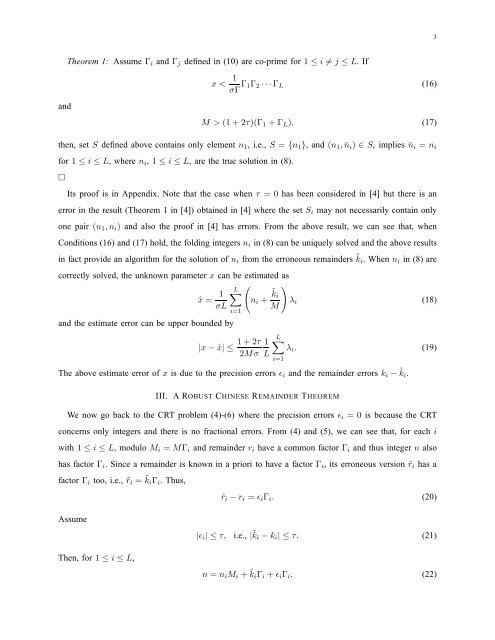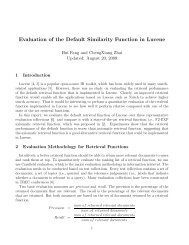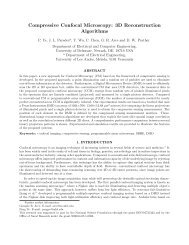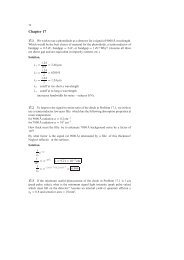Phase Unwrapping and A Robust Chinese Remainder Theorem
Phase Unwrapping and A Robust Chinese Remainder Theorem
Phase Unwrapping and A Robust Chinese Remainder Theorem
Create successful ePaper yourself
Turn your PDF publications into a flip-book with our unique Google optimized e-Paper software.
3<br />
<strong>and</strong><br />
<strong>Theorem</strong> 1: Assume Γ i <strong>and</strong> Γ j defined in (10) are co-prime for 1 ≤ i ≠ j ≤ L. If<br />
x < 1<br />
σΓ Γ 1Γ 2 · · · Γ L (16)<br />
M > (1 + 2τ)(Γ 1 + Γ L ), (17)<br />
then, set S defined above contains only element n 1 , i.e., S = {n 1 }, <strong>and</strong> (n 1 , ¯n i ) ∈ S i implies ¯n i = n i<br />
for 1 ≤ i ≤ L, where n i , 1 ≤ i ≤ L, are the true solution in (8).<br />
□<br />
Its proof is in Appendix. Note that the case when τ = 0 has been considered in [4] but there is an<br />
error in the result (<strong>Theorem</strong> 1 in [4]) obtained in [4] where the set S i may not necessarily contain only<br />
one pair (n 1 ,n i ) <strong>and</strong> also the proof in [4] has errors. From the above result, we can see that, when<br />
Conditions (16) <strong>and</strong> (17) hold, the folding integers n i in (8) can be uniquely solved <strong>and</strong> the above results<br />
in fact provide an algorithm for the solution of n i from the erroneous remainders ˜k i . When n i in (8) are<br />
correctly solved, the unknown parameter x can be estimated as<br />
(<br />
ˆx = 1 L∑<br />
n i + ˜k<br />
)<br />
i<br />
λ i (18)<br />
σL M<br />
<strong>and</strong> the estimate error can be upper bounded by<br />
i=1<br />
|x − ˆx| ≤ 1 + 2τ<br />
2Mσ<br />
1<br />
L<br />
L∑<br />
λ i . (19)<br />
The above estimate error of x is due to the precision errors ǫ i <strong>and</strong> the remainder errors k i − ˜k i .<br />
i=1<br />
III. A ROBUST CHINESE REMAINDER THEOREM<br />
We now go back to the CRT problem (4)-(6) where the precision errors ǫ i = 0 is because the CRT<br />
concerns only integers <strong>and</strong> there is no fractional errors. From (4) <strong>and</strong> (5), we can see that, for each i<br />
with 1 ≤ i ≤ L, modulo M i = MΓ i <strong>and</strong> remainder r i have a common factor Γ i <strong>and</strong> thus integer n also<br />
has factor Γ i . Since a remainder is known in a priori to have a factor Γ i , its erroneous version ˜r i has a<br />
factor Γ i too, i.e., ˜r i = ˜k i Γ i . Thus,<br />
Assume<br />
Then, for 1 ≤ i ≤ L,<br />
˜r i − r i = ǫ i Γ i . (20)<br />
|ǫ i | ≤ τ, i.e., |˜k i − k i | ≤ τ. (21)<br />
n = n i M i + ˜k i Γ i + ǫ i Γ i . (22)











